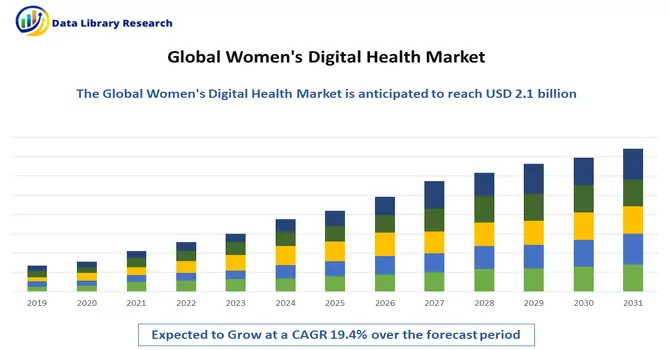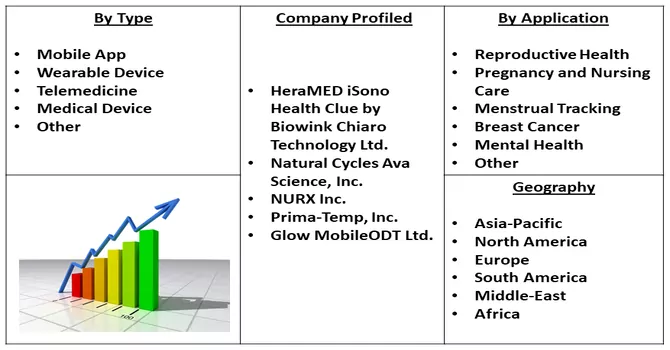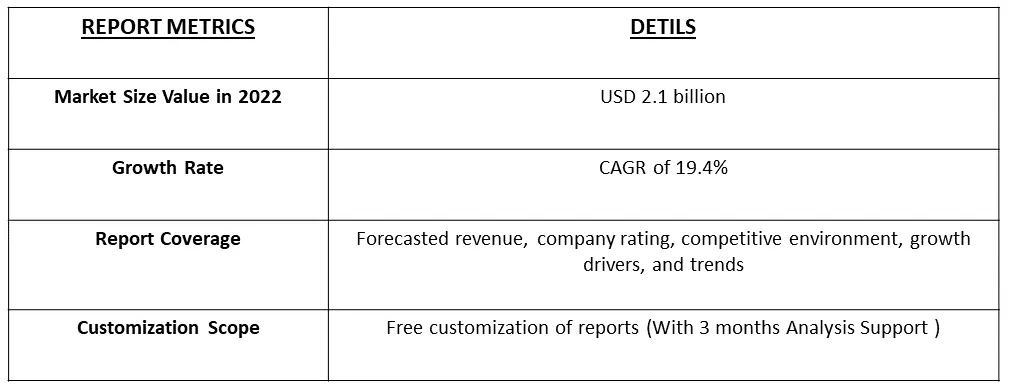The Women’s Digital Health Market is currently valued at USD 2.1 billion in the year 2022 and is expected to register a CAGR of 19.4% over the forecast period, 2023-2030.

Get Complete Analysis Of The Report - Download Free Sample PDF
The rise in smartphone penetration, adoption of preventive healthcare, favourable regulations, and rise in funding are the factors propelling market growth and awareness. Around 50.0% of the world’s population is women and there were around one billion women in 2019 with a mobile device capable of using modern-day digital tools. Furthermore, the rising number of chronic and general illnesses and infectious diseases depicts the market potential for digital women’s healthcare. The conducive regulatory environment, enabling approval of contemporary digital applications and devices catering to conventional women’s health issues, is further boosting the market growth.
Women's digital health apps allow women to quickly evaluate and address their health issues because they collect real-time data. Also, there are applications for women's health monitoring on the market that concentrate on the particular primary ailments to which women are predisposed.
Segmentation:
The Women’s Health Market is Segmented
By Type
By Application
Geography
The report offers the value (in USD million) for the above segments.

For Detailed Market Segmentation - Download Free Sample PDF
Women’s digital health refers to the initiatives made by industry participants and researchers that include technical solutions, such as mobile apps, software, wearables, and diagnostic tools, that are specifically designed to help improve the health and wellness of females. Fertility, pregnancy management, and contraception are the major areas of digital women’s health that have received the most attention so far. Some FemTech companies also concentrate on diagnosing anxiety and depression, cervical examination and screening, and contraception.
Moreover, the women’s digital health sector is incorporating artificial intelligence to achieve life-changing results in oncology by early monitoring and diagnosis of a range of diseases, including polycystic ovarian, endometriosis, assistive reproduction syndrome, and cervical, ovarian, and breast cancers.
Driver:
Rising awareness & and growing adoption of digital health solutions among women for health management
An article published by NCBI in August 2022, reported that in the United States, almost 90% of women are at risk of at least one chronic condition. However, the awareness, management, and monitoring of these conditions are low and present a substantial public health problem. Digital health tools can be leveraged to reduce the alarmingly high rates of chronic condition–related mortality and morbidity in women. This study suggests that women with chronic conditions accept and integrate digital health tools to manage their care. Thus, increasing instances of chronic diseases among women are driving the growth of the studied market.
Additionally, in August 2021, Athenahealth and the Smile Foundation launched the Smile on Wheels mobile health unit in Chennai. Athenahealth is providing financial support to a Smile on Wheels mobile health unit, which will offer primary healthcare services in an area of Chennai with approximately 17,600 households and 88,000 residents. Smile on Wheels is a national-level mobile hospital program catering to underprivileged children and women. The program sends medical vans along with specialized doctors, nurses, medical staff, and medicine to identified villages and underserved communities to provide crucial access to healthcare services.
Growth in investments and funding and Technological Advancements
Mobile health apps can improve patient engagement by providing personalized health information and enabling patients to track their health data. Patients can monitor their symptoms, track medication adherence, and receive notifications for appointments and important health updates. Also, In June 2023, an article published by Mercom Capital Group reported that mHealth Apps raised USD 912 million in Q1 2021. The funding increased by 117% quarter-over-quarter compared to USD 421 million raised in Q4 2020. Thus the benefits offered by digital health services are increasing due to technological advancements, as a result leading to increased funding, thereby contributing to the studied market’s growth.
Furthermore, in recent years, the number of Internet applications in healthcare has increased exponentially. The internet has linked all the points in healthcare administration/services and created a separate network, the IoT, for healthcare. With the help of the internet, healthcare professionals can deliver health information to consumers more conveniently, in less time, and at a reduced cost. A growing preference for mobile technology and the internet and mounting demand for digital health is expected to boost the market growth.
Restraints:
Data Privacy and Security Issues
Many of the most popular women's mHealth apps on the market have poor data privacy, sharing, and security standards. Although regulations exist, such as the European Union General Data Protection Regulation, current practices do not follow them.
The COVID-19 pandemic had a relatively positive impact on the overall market. Mobile health emerged as a new savior to avoid the further spread of infection and protect front-line workers and patients alike. Mobile health solutions, primarily through smartphones and remote monitoring, became a lifeline for consultations. The primary factor was that many healthcare professionals took a two-way approach to treating patients. Therefore, the rising cases of COVID-19 increased the mobile health business in the short term. In the long run, this situation accelerated the wide adoption of digital solutions, especially those with remote care components. Before the pandemic, technology was on the back end in most hospitals, which created an opportunity to get in front by dealing with patients through online gateways. For instance, as per Becker's Healthcare Report, during the first three-quarters of 2021, there were 251 digital health investment deals. To improve the health of populations, mobile health platforms have gained traction during the COVID-19 pandemic. The rising penetration of digital health services for remote patient monitoring is also increasing the demand for mobile health apps, even after the pandemic, which in turn is expected to propel market growth over the forecast period. Thus, the COVID-19 pandemic had an impact on the mobile health (mHealth) market and is expected to do so in the long run.
Segmental Analysis:
Mobile App Segment is Expected to Witness Significant Growth Over the Forecast Period Women’s health mobile app encompasses all facets of a woman's life, from menopause and period tracking and dating applications to platforms that discuss motherhood, professional development, and emotional and physical toughness. Furthermore, the launch of a new women’s mobile health app is expected to drive the growth of the segment. For instance, in May 2019, Vivant launched 'Nyra', a simple mobile application that can be used by women to track their period, fertility, ovulation, mood, lifestyle, and physical activity. Thus, the segment is expected to witness significant growth over the forecast period.
Menstrual Tracking Application is Expected to Witness Significant Growth Over the Forecast Period
Period tracking applications (apps) allow women to track their menstrual cycles and receive a prediction for their period dates. The majority of apps also provide predictions of ovulation day and the fertile window. For instance, Flo is a multifunctional application where girls and women can find a period tracker, cycle forecasting, ovulation calendar, and useful information about pregnancy preparation, conception, early stages of motherhood, and even menopause. Thus, such developments are driving the growth of the studied market.
North America is Expected to Witness Significant Growth Over the Forecast Period
North America dominated the overall market as the region will expand further at a steady growth rate, maintaining its market position over the forecast period. This growth was attributed to the early approval & and commercialization of products, favorable reimbursement policies, supportive government regulations, and high awareness about the importance of maintaining good health. For instance, in the financial year 2020-2021, the Government of Canada provided USD 50.47 million for family planning due to which 2.5 million women and couples received contraceptive supplies and services. Thus, the region is expected to witness significant growth over the forecast period.

Get Complete Analysis Of The Report - Download Free Sample PDF
Competitive Landscape:
The Women’s digital health Market is highly fragmented due to the presence of many global and regional players working in this segment. Some of the key market players working in this segment are-
Recent Development
1) In March 2023: A women’s health app that acts as an “empathetic AI companion” was launched in the App Store. The app has focused on making medical jargon more accessible and utilizing reinforcement learning from human preference to connect women.
2) In April 2021: Nabla, a French startup launched a new app focused on women’s health. Nabla offers several services that should all contribute to helping you stay healthy. In short, Nabla lets you chat with practitioners, offers community content, helps users centralize all their medical data, and will soon offer telemedicine appointments. Nabla’s key feature is the ability to start a conversation with health professionals and one can send a message to a general practitioner, a gynecologist, a midwife, a nurse, a nutritionist, or a physiotherapist.
Q1. How big is the Women's Digital Health Market?
The Women’s Digital Health Market is currently valued at USD 2.1 billion in the year 2022 and is expected to register a CAGR of 19.4% over the forecast period, 2023-2030.
Q2. What is the Growth Rate of the Women's Digital Health Market?
Women's Digital Health Market is expected to register a CAGR of 19.4% over the forecast period.
Q3. What are the factors on which the Women's Digital Health Market research is based on?
By Type, By Application & Geography are the factors on which the Women's Digital Health Market research is based.
Q4. Which Region is expected to hold the highest Market share?
North America Region is expected to hold the highest Market share.
Data Library Research are conducted by industry experts who offer insight on industry structure, market segmentations technology assessment and competitive landscape (CL), and penetration, as well as on emerging trends. Their analysis is based on primary interviews (~ 80%) and secondary research (~ 20%) as well as years of professional expertise in their respective industries. Adding to this, by analysing historical trends and current market positions, our analysts predict where the market will be headed for the next five years. Furthermore, the varying trends of segment & categories geographically presented are also studied and the estimated based on the primary & secondary research.
In this particular report from the supply side Data Library Research has conducted primary surveys (interviews) with the key level executives (VP, CEO’s, Marketing Director, Business Development Manager and SOFT) of the companies that active & prominent as well as the midsized organization
FIGURE 1: DLR RESEARH PROCESS

Extensive primary research was conducted to gain a deeper insight of the market and industry performance. The analysis is based on both primary and secondary research as well as years of professional expertise in the respective industries.
In addition to analysing current and historical trends, our analysts predict where the market is headed over the next five years.
It varies by segment for these categories geographically presented in the list of market tables. Speaking about this particular report we have conducted primary surveys (interviews) with the key level executives (VP, CEO’s, Marketing Director, Business Development Manager and many more) of the major players active in the market.
Secondary ResearchSecondary research was mainly used to collect and identify information useful for the extensive, technical, market-oriented, and Friend’s study of the Global Extra Neutral Alcohol. It was also used to obtain key information about major players, market classification and segmentation according to the industry trends, geographical markets, and developments related to the market and technology perspectives. For this study, analysts have gathered information from various credible sources, such as annual reports, sec filings, journals, white papers, SOFT presentations, and company web sites.
Market Size EstimationBoth, top-down and bottom-up approaches were used to estimate and validate the size of the Global market and to estimate the size of various other dependent submarkets in the overall Extra Neutral Alcohol. The key players in the market were identified through secondary research and their market contributions in the respective geographies were determined through primary and secondary research.
Forecast Model
